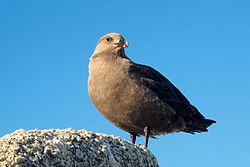| South polar skua | |
|---|---|
 | |
| A south polar skua in Terra Nova Bay | |
| Scientific classification | |
| Domain: | Eukaryota |
| Kingdom: | Animalia |
| Phylum: | Chordata |
| Class: | Aves |
| Order: | Charadriiformes |
| Family: | Stercorariidae |
| Genus: | Stercorarius |
| Species: | S. maccormicki |
| Binomial name | |
| Stercorarius maccormicki Saunders, 1893 | |
 | |
| Synonyms | |
Catharacta maccormicki | |
The south polar skua (Stercorarius maccormicki) is a large seabird in the skua family, Stercorariidae. An older name for the bird is MacCormick's skua, after explorer and naval surgeon Robert McCormick, who first collected the type specimen. This species and the other large skuas, such as the great skua, are sometimes placed in a separate genus Catharacta.


